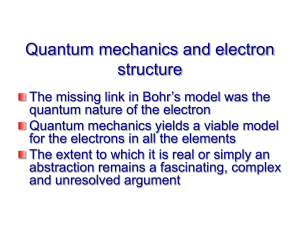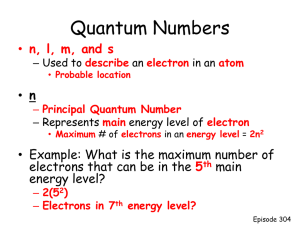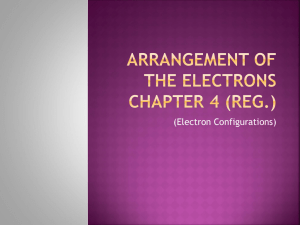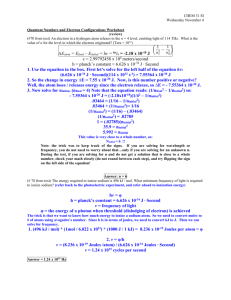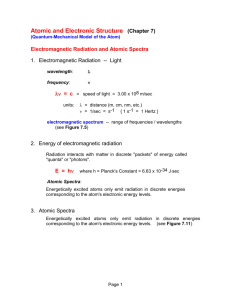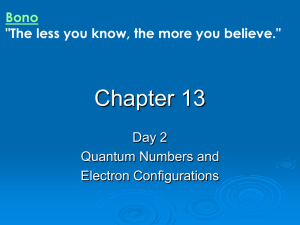QuantumNumbers_Printable
advertisement
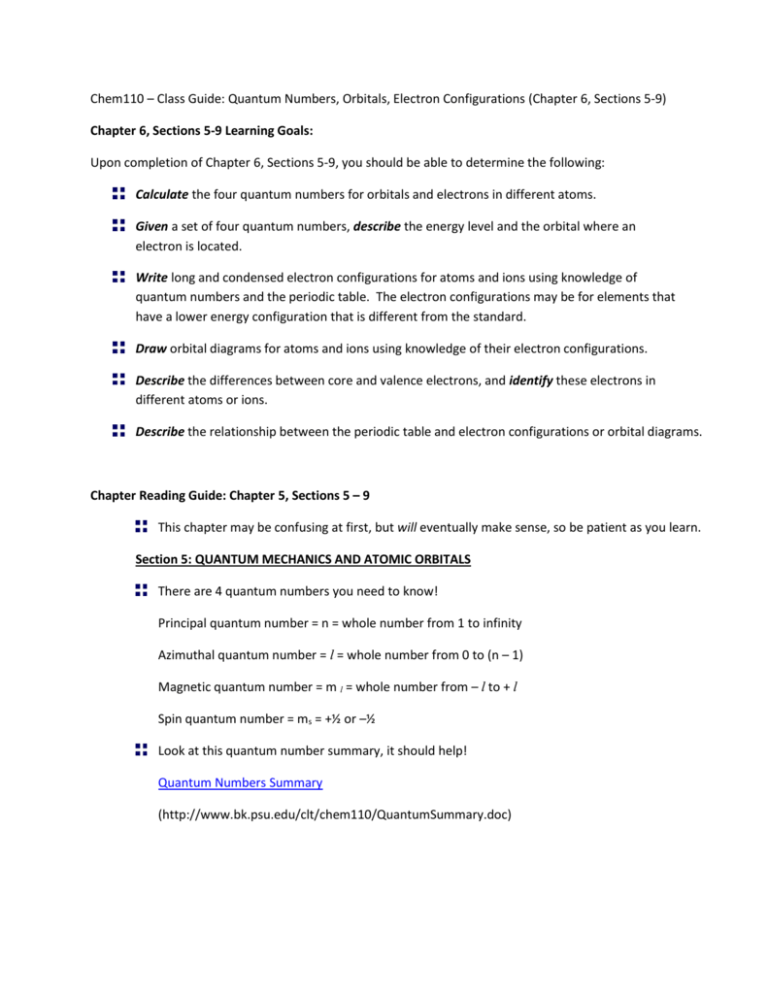
Chem110 – Class Guide: Quantum Numbers, Orbitals, Electron Configurations (Chapter 6, Sections 5-9) Chapter 6, Sections 5-9 Learning Goals: Upon completion of Chapter 6, Sections 5-9, you should be able to determine the following: Calculate the four quantum numbers for orbitals and electrons in different atoms. Given a set of four quantum numbers, describe the energy level and the orbital where an electron is located. Write long and condensed electron configurations for atoms and ions using knowledge of quantum numbers and the periodic table. The electron configurations may be for elements that have a lower energy configuration that is different from the standard. Draw orbital diagrams for atoms and ions using knowledge of their electron configurations. Describe the differences between core and valence electrons, and identify these electrons in different atoms or ions. Describe the relationship between the periodic table and electron configurations or orbital diagrams. Chapter Reading Guide: Chapter 5, Sections 5 – 9 This chapter may be confusing at first, but will eventually make sense, so be patient as you learn. Section 5: QUANTUM MECHANICS AND ATOMIC ORBITALS There are 4 quantum numbers you need to know! Principal quantum number = n = whole number from 1 to infinity Azimuthal quantum number = l = whole number from 0 to (n – 1) Magnetic quantum number = m l = whole number from – l to + l Spin quantum number = ms = +½ or –½ Look at this quantum number summary, it should help! Quantum Numbers Summary (http://www.bk.psu.edu/clt/chem110/QuantumSummary.doc) Section 5 and 6: REPRESENTATIONS OF ORBITALS Certain values of azimuthal quantum number, l , have special names: l value Name Shape 0 s orbital Sphere 1 p orbital Dumbbell 2 d orbital Clover (except one dumbbell with a donut around its middle) 3 f orbital Complicated… As the orbitals get further from the nucleus (increase in n value), they get larger and are more unstable (higher in energy). Section 7: MANY-ELECTRON ATOMS As orbitals get further away from the nucleus (as their n increases), they increase in energy (example: 2s < 3s < 4s) Within the same n level, as the value of the azimuthal quantum number increases, the orbitals increase in energy (example: 3s < 3p < 3d) The Pauli Exclusion Principle states that every electron in an atom must have a unique set of quantum numbers (somewhere in the 4 quantum numbers, there must be a difference!) Each orbital on an atom can only hold two electrons s orbital = 1 per n level = 2 electrons can fit in the s orbital p orbital = 3 per n level = 6 electrons can fit in the p orbital d orbital = 5 per n level = 10 electrons can fit in the d orbital f orbital = 7 per n level = 14 electrons can fit in the f orbital Section 8: ELECTRON CONFIGURATIONS Watch the following movie: Electron Configuration (http://www.bk.psu.edu/clt/ElectronConfigurations.mov) TIP! You are learning a new language as you learn about electrons so watch the movie several times to ensure you understand the language the narrator uses! Electron configurations give us a short-hand of the quantum numbers for each atom. The short-hand is nl#, where n = principal quantum number, l = azimuthal quantum number, and # = number of electrons. Example: S = 1s22s22p63s23p4 But this gets tiresome, so we use a short-hand for even this, and use the noble gas before it in brackets: S = [Ne]3s23p4. You can never write just a noble gas, so if you are asked to do Ne, the answer is NOT Ne = [Ne]. Instead, it’s Ne = [He]2s22p6. Hund’s Rule states that electrons will always occupy the lowest energy level available to it (remember those rules about quantum numbers and energy levels? They’re back!). Because of Hund’s Rule, there are a few twists to electron configurations. In general, when they are empty, the d orbital is higher in energy than the s orbital of one n level up. So, if we’re doing an element past n = 3, like Ti, we will fill the 4s orbital before we fill the 3d orbital! Ti = [Ar]4s23d2 The second twist is that, when empty, the f orbital is higher in energy than the s orbital two n levels up! Hf = [Xe]6s24f145d2 Try Practice Exercise 6.7. Section 9: ELECTRON CONFIGURATIONS AND THE PERIODIC TABLE: The periodic table has sections on it that correspond to quantum numbers, which makes writing electron configurations easier. Generally, the group number corresponds to the n level (be careful of those d orbitals and f orbitals though!) The first two groups on the periodic table have electron configurations that end with s orbitals. The transition metals have electron configurations that end with d orbitals. Groups 3A – 8A have electron configurations that end with p orbitals. The lanthanides and actinides have electron configurations that end with f orbitals. Try Practice Exercises 6.8 and 6.9 Learning Resources Chapter Learning Goals Chapter 6, Sections 5 - 9 Learning Goals Additional Chapter Resources Watch this movie: Electron Configuration (http://www.bk.psu.edu/clt/ElectronConfigurations.mov) Quantum Numbers Summary (http://www.bk.psu.edu/clt/QuantumSummary.doc) Pre Class Assignment: This assignment must be completed prior to the next class. Check your syllabus for the exact due date and time. Complete the pre class assignment (http://berks.psu.edu/clt/chem110/QuantumNumbers_HW.doc) Submit a copy to the dropbox located in ANGEL called “Pre Class Assignment Submission: Quantum Numbers, Orbitals and Electron Configurations” End of Chapter Problems: Practice with these problems if you are having difficulty with any of the concepts covered in this class guide AFTER we have met in class. If you cannot easily complete these problems, seek help from your instructor, your mentor, or the learning center. Chapter 6: 51, 53, 55, 65, 69 (a, b, c, d, f only), 71 (a, b, d only), 73 , 90
